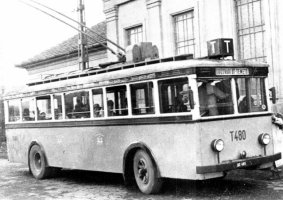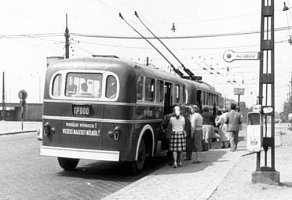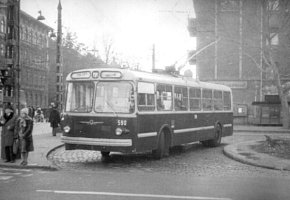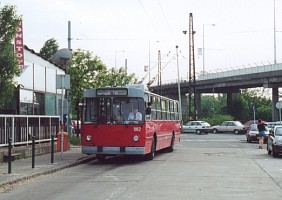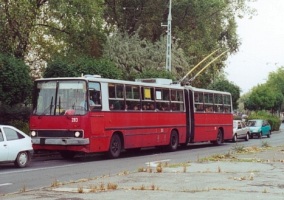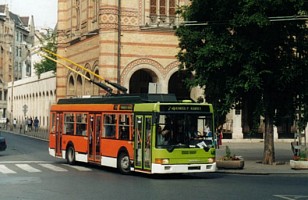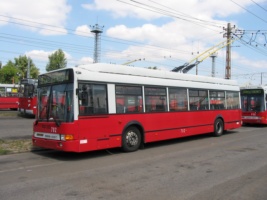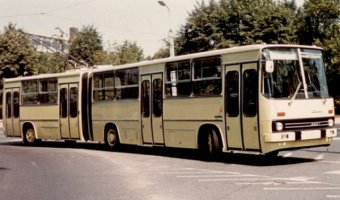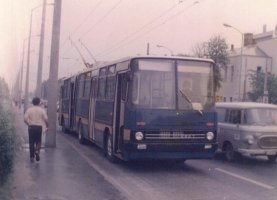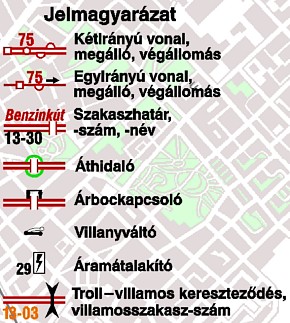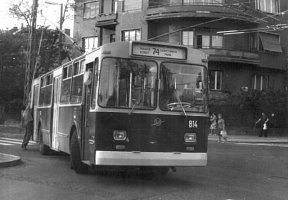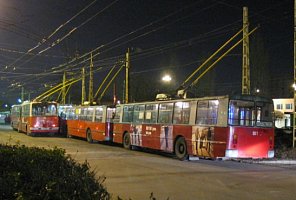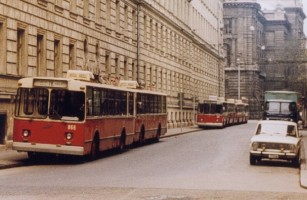- (by NZA)
The idea to prepare this page came originally from Hamster (alias Varga Ákos Endre), who started to write a manual to introducte the tramroutes of Budapest. Though this series is still far from being finished, I was surprised to see the interest raised on Budapest. In fact, so much surprised, that I became inspired to write a similar page to introduce the trolleybus service, which also an interesting and historical system, but it plays only a secondary role near the trams - but it has the advantage that to prepare such a page is actually shorter. In the following I am trying to cover the history of the trolleybus, show all types of vehicles in service nowadays, and finally to give some hints, what is to see along the trolleybus routes. I hope this page will be useful for those also, who in the future want to explore the trolleybus network of Budapest.
- History of the trolleybuses
- The Óbuda line
The post-war boom
The second flourishing: the construction of Zugló-lines
Recent changes
The fleet of the
trolleybuses of the BKV
- Numbering scheme
Trolleybus types
- ZIU-9 trolleybuses
Ikarus-280 (GVM) trolleybuses
Ikarus-435 trolleybuses
The first low-floor trolleybus: Ikarus-411
Ikarus-412 trolleybuses
Solaris T12 trolleybuses
Experimental trolleybuses
Museum cars
- Map
Roads & wires
Interesting spots
The fourteen routes
"Lost wires"
The garage
Unusual events
History of the trolleybus in Budapest
 |
|
|
|
|
The first trolleybus line in Budapest was opened on 16th December 1933 in Óbuda, from the Vörösvári út terminus (today tram terminus of routes 1 &17). The trolleybuses along the 2.7 km long line reached the Cemetry in 8 minutes. The vehicles used Óbuda-depot, that was situated near the terminus. There were two Ganz and one MÁVAG-Boveri trolleybuses, both had a boxy shaped body but different electric equippment. Until 1941 the cars were used left-hand side driving way, after changing the direction, the bodies of the three trolleybuses were replaced in two months. The route was destroyed in 1944, during the siege of Budapest. The three trolleybuses were used after the war as learner cars, and even put again to regular passanger service in 1953.
 |
|
|
|
|
The trolleybus in Pest was opened on 21st December 1949, with the new line 70. Even before the war there were several projects to replace the trams in narrow streets. After the Sowiet Union was able to export MTB trolleybuseses for Budapest, the council decided first to replace the tramroute 10. The opening of the line gave a possibility to the Communist Party to make a big propaganda around the "gift of the Sowiet Union and comrade Stalin". At this year Stalin celebrated his 70th birthday, this is the origin of the route number. In the following years (until 1956) the Ganz-factory started the mass production of the IK-60 trolleybuses, and several new routes were opened in the city center (the today existing routes 72, 73, 75, 76, and the Baross utca route, which was at the time route 74), most of them replacing former tramlines. In the revolution of 1956 most of the wiring was destroyed, which was rebuilt in the following year. Soon, there was further new routes opened around Baross tér, whith opening two new lines (78, 79).
Extremely large traffic was on route 75, which formed a belt on the outer boulevards. This required the increasing the size of the vehicles, which in 1960 lead to the use of trailers. The trailer service lasted until 1968. In 1961 started the rebuilding program of the IK-60T cars into articulated trolleybuses. With the use of a scrapped autobus for the rear part, the FAÜ and FVV produced 54 IK-60TCS articulated cars. In the meantime, between 1966-69 the FVV (and later the BKV) purchased 100 ZIU-5 trolleybuses again from the Sowiet Union. However, in the end of the '60s the local council was willing to convert the trolleybus lines to autobus. This lead to the closing of the Baross utca line in 1973.
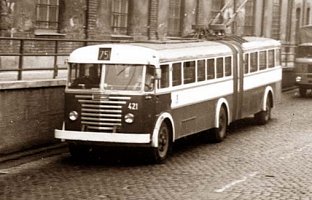 |
|
|
|
|
The second flourishing: the construction of Zugló-lines
The change of the policy came in 1974 in favour of the trolleybuses, after the price of the oil increased even in the Comecon countries. The council decided to purchase new vehicles to replace the overaged solo and articulated IK-60T trolleybuses. After 1975 started the import of the ZIU-9 solo trolleybuses, however no country was able to produce articulated trolleybuses in the socialist block. This lead to the production of the home-made articulated trolleybuses, whith using the succesful Ikarus-280 bodies and the early-scrapped ZIU-5's electric equippments. This series became the series 100 (actually the numbers used for the second time).
The increased amount of vehicles were sufficient for the new Zugló-lines (74, 77, 80, 81, 82), and the reopened Baross utca line (83) between 1977-83. Also new trolleybus routes replaced the former tramline 15 and 25, with the lengthening and modifing the routes 72 and 79 in 1977. There were serious plans to build trolleybus lines in Buda-hills starting from Moszkva tér. The first line was supposed to be replacing tramline 58, but finally no trolleybus wire was built in this area. In the middle '80s with the start of the the production of the GVM trolleybuses, new trolleybuses with modern electronics were introduced in the fleet.
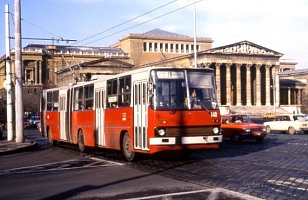 |
|
|
|
|
In the '90s the general economical situation
did not allowed big investments. In 1994 and 2002 only 15-15 new trolleybuses
were bought from Ikarus-Obus-Kiepe, and some changes were in the network.
With the forming the big tramring of the route 1, the line 75 was shortened,
modifying the garage-route of route 83 too. There was a short extension
of route 82 too. There are some projects changing the trolleybus routes
around Baross tér (Keleti pu.), starting with constructing a new loop for
route 80. However recently there are no plans for opening new lines. Nowadays
the scrapping of the ZIUs became very urgent, in four years the BKV wants
to buy 45 new low-floor Ganz-Solaris trolleybuses for the inner city routes.
 |
|
|
The trolleybus fleet
In the following chapter I will show the trolleybus fleet of the BKV, in its form 2004. There are alltogether 164 (+2 learner) vehicles, however in this next year (2005) further six Ganz-Solaris solo low-floor trolleybuses are expected to arrive, with the continuous scrapping of the ZIUs.
The first numbers of the trolleybuses in 1933 were just continuing the three-digit numbering scheme of the autobuses, with an extra sign T in the front. However, as after the war the autobuses changed their licence numbers, the BSzKRt's three-digit series has been solely devoted to the trolleybuses. Thus there were 1000 numbers (000-999) for the denomination of the new series. As the average lifespan of a trolleybus is shorter, than tramcars', in the recent five decades basically all trolleybus numbers were already used two times. The letter T has dissapeared in the '60s. Now there is a general rule, that there must not be the same number used by all Hungarian operators, this is the reason why in Szeged and Debrecen one can find more strange looking schemes - which actually does not affect the Budapest scheme.
The current fleet in service uses the following
numbers:
- 200 series: Ikarus - Ganz IK-280.93T
articulated trolleybuses + an extra car 283 (84 cars)
300 series: Ikarus - Obus - Kiepe IK-435T trolleybuses (15 cars)
400 series: a single Ikarus - Obus - Kiepe IK-411T low-floor trolleybus
600 series: the recently purchased Ganz-Solaris T12 low floor trolleybuses
700 series: Ikarus - Obus - Kiepe IK-412.81T low-floor trolleybuses (15 cars)
800-900 series: Russian ZIU-9B solo trolleybuses (49+2 cars)
The experimental cars are recetly were
numbered to the end of the 100 series: the latest was a demonstrator
articulated Solaris trolleybus built for Rome, which ran with the temporary
number
196 in 2004.
An
up-to-date list can be found on Bálint Hajtó's homepage.
Trolleybus types
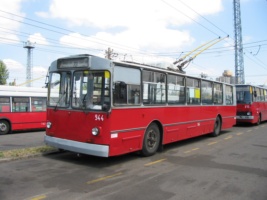 |
|
|
|
|
These russian made trolleybuses are certainly the veterans not just of the Budapest fleet, but I think there are no other operators in the world, who still uses such an early version of this trolleybus type! Right after the appearence of the first experimental cars in the Sowiet Union, in Budapest appeared the first two ZIU-9 trolleybuses (800 & 801) in 1975. Alltogether there were 173 such trollybuses bought (800-972) between 1975-84, in the end of 2004 there were 51 cars in the fleet. The oldest amongst them still in everyday service is car 882 (usually runs on route 74 or 74A) is 27 years old! This is really an old age, it has ran already over 900,000 km! Even one year older are the two learner cars (833 and 840).
Actually, ZIU-9 and its modernized forms are still in commercial production for the former Sowiet countries. However these cars were not perfectly assembled when they arrived, since then the cars still in service were at least three times fully reconstructed, whith excessive use of Ikarus parts. Even now they can be held in service with continuous efforts, one could see several cars with obvious sings of wearing down (e.g. holes on the side panels, or deformed wrapping inside). Originally these cars had trolley retrievers, which was removed - thus the rewiring is done with a pole, which is put in the end of the cars.
There are some special cars in the fleet. Trolleybus 887 (runs on route 74-74A) is actually a former car from Szeged (ex 9-138), whith some signatures of its different origins. The car 972 (route 76) was previously a trolleybus with modified electric equippment meant to use on steeper gradients of the proposed Buda routes. After its reconstruction there is no external sign left of its different origin. There are ten trolleybuses (and the learner car 833) of the reconstruction series of 2000, which obtained a microprocessor driven electrics (908, 923, 925, 931, 941, 955, 960, 966, 967, 969).
Routes: 73, 74, 74A,
76,
78
(weekdays)
Ikarus-280 (GVM) trolleybuses
The 84 vehicles (200-283) of these articulated trolleybuses make the biggest part of the Budapest fleet. With its smooth, fast ride and easy driving makes the most beloved type amongst the drivers. This type was the first series introduced with thyristroic chopper control, with extremely high energy recuperation rate amongst similar constructions. As their rear axle is steered and tha axle distance is smaller, these car can actually easier manouvre in the narrow streets of the inner city, than the ZIUs!
There are three special cars remained: originally the first seven cars, now only two trolleybuses (202 & 205) have folding doors (these cars usually run on route 79 & 81). The other five were recently rebuilt with flapping doors. Special car is the last one (283) which was originally an experimental car using old sowiet technology. In 1996 it was rebuilt with Ganz electronics, however its construction still shows its origin (the ventillation gap is missing on the left side). This car usually run on route 77 or 83. With recent reconstructions some minor parts of the regulation has been changed on the fleet, and the majority of the GVM cars obtained electronical displays.
Routes: 72, 75, 77,
79,
81,
82,
83
(occasionally on 80 too).
Ikarus-435 trolleybuses
The first series of electronical vehicles, that used GTO based three-phase AC technology was the Ikarus-Obus-Kiepe trolleybuses built between 1994-96. These trolleybuses (300-314) run usually on route 80, as the corners of the inner city is to narrow for them. These cars a considerably slower than the GVMs, however they are much more silent and more friendly to the passengers. The first three (300-302) has still conventional plastic panels as route signs, however the rest is already fitted with electronic displays.
Routes: 80 (occasionally on 77).
The first low-floor trolleybus: Ikarus-411
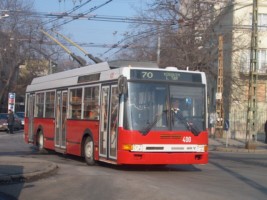 |
|
|
|
|
This trolleybus was an experiment of the Ikarus and Obus Ltd. Co., fitted with similar GTO-electronics as the 300 series. It was made in 1995, and it obtained the number 400. It was used as a demonstrator in several countries, in 2001 it was officially given to the BKV. Its original liveries were green, with an orange part imitating an old trolleybus on the side. After 2001 it was repainted to the BKV's conventional dark-red colors.
Routes: 74 (rarely on 70
or 74A)
Ikarus-412 trolleybuses
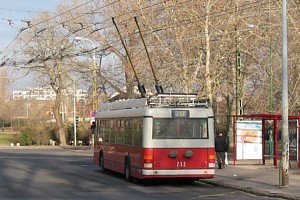 |
|
|
|
|
In 2002 15 new Ikarus trolleybuses were bougth (700-714). These trolleybuses were assembled by Obus ltd. with using Ikarus and Kiepe as the producer of the body and the IGBT-electronics.
Routes: 70, 74 (a single
car on weekend with scheduled runs daytime), 78 (weekends)
Solaris T12 trolleybuses
In the beginning of 2005 six new Solaris
T12 trolleybuses arrive, they are scheduled to run from the middle of March
on route 76. These will obtain the numbers in the 600 series (601-606).
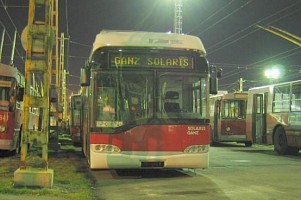 |
|
|
Experimental trolleybuses
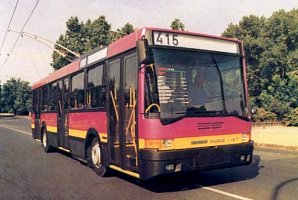 |
|
|
|
|
I think, the reader will be very surprised on the amount of experimental cars running on the Budapest system in the past. Not just the Ikarus and Ganz-factory uses the network as a natural testtrack, but the BKV itself has produced experimental cars. In fact, the Budapest network makes a big challange for the trolleybuses with modern electronics: the cars have to be able to operate the old fashioned switches (with current impulse), and survive the extreme amount of insulated and short-cut sections of the network crossings. Usually in the inner city, every 400 meters there is some equippment on the trolleybus wire.
Let me just put here a list of the experimental vehicles:
|
|
|
|
|
|
|
|
|
|
|
|
|
|
|
|
|
|
|
|
|
|
|
|
|
|
|
|
|
|
|
|
|
|
|
|
|
|
|
|
|
|
|
|
|
|
|
|
|
|
|
|
|
|
|
|
|
|
|
|
|
|
|
|
|
|
|
|
|
|
|
|
|
|
|
|
|
|
|
|
|
|
|
|
|
|
|
|
|
|
|
|
|
|
|
|
|
|
|
|
|
|
|
|
|
|
|
|
|
|
|
|
|
|
|
|
|
|
|
|
|
|
|
|
|
|
And here are the series
which were (are) tested in Budapest:
|
|
|
|
|
|
|
|
|
|
|
|
|
|
|
|
|
|
|
|
|
|
|
|
|
|
|
|
|
|
|
|
|
|
|
|
|
|
|
|
|
|
|
|
|
|
|
|
|
|
|
|
|
|
|
|
|
|
|
|
The recent products of Ganz-Transelektro.
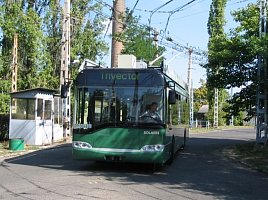 |
|
|
|
|
Museum cars
The only fully operational museum trolleybus
of Hungary can be seen in Szentendre, at the museum
of urban transport (near the HÉV station). This is ZIU-5 trolleybus
573.
There are four more vehicles waiting to be restored. This is a solo MTB
trolleybus (the rebuilt version of it), a solo IK-60T trolleybus (T323
-> 259), an articulated Ikarus-Dynamo trolleybus (156) and
the prototype of the Ikarus-260 trolleybus (600). These vehicles
all standing at Pongrác-depot, in the "pit". There exists a trailer for
the trolleybus (923) used in the '60s. I'm afraid, in the near future
it is not likely, that any of these will be restored. The ZIU-9 learner
car 840 has also been reconstructed, with the purpose of future
displaying in Szentendre.
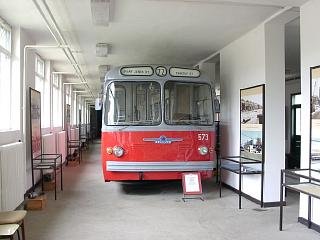 |
|
|
Today's network
A large scale full map of the system from 2002 can be found here. Since then there were two major changes:
- the route 75 is shortened to Népstadion, with abandoning the trolleywires from Kőbányai út to Népliget. The garage route of route 83 was put on Kőbányai út;
- route 82 was lengthened to Erzsébet királyné útja (two stops beyond Thököly út).
Key to the map:
|
I guess, we must praise at this point to that wise man, who in 1949 insisted on the use of the more complicated Kummler & Matter trolleybus overhead wire system, than the usual rigid system common in Eastern-Europe. The roads of Budapest are often poor, especially the old cabblestone parts (like Nefelejcs utca). Even the asphalted roads are often in an apalling situation (like Király utca, Izabella utca or Kálmán Imre utca).The reason why still the trolleybuses can still run here with normal speed without fear of dewiring is the soft K&M suspension of wires. The GVMs can go even here quite smoothly, but the ZIUs can really feel each bumps.
The inner city routes often run in narrow streets: e.g. in certain points of Nagymező utca (routes 70 & 78) the trolleybuses going the opposite direction cannot pass near each other. The tightest spots of the network are situated on route 74 (Wesselényi utca, Dohány utca), the trolleybus drivers really have a skill to dare to go in such places with the old ZIUs. During weekdays the trolleybuses often stuck in the congestion, especially in the inner city routes. There are less problems during summertime, but the worst traffic jams can be in the shopping season before Christmas.
The operation of the switches are done by current impulses at setting sections. Cars going in one direction always operate the switch, while in the other direction never do so. The current impulses on the ZIUs and GVMs are simply produced by accelerating under this setting section. There are so called direct-switches (most of them are in the depots, and there is one for route 73 & 76 at Bethlen Gábor utca). These direct-switches has to be operated right at the place when the trolley reaches the switch itself, thus it takes again some skill to operate them correctly (meaning these are the places most likely to see dewiring).
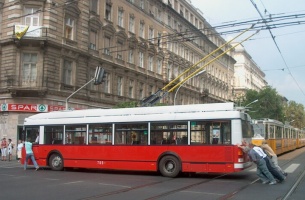 The
complicated inner city routes form many crossings too. These are in good
condition, however more problems can be caused by the tram crossings especially
of the Grand-Boulevard (routes 70, 72, 73, 74 & 78). Generally the
tram-trolleybus crossings are insulated for the trolleybuses, menaing long
dead section, where the trolleybus must roll through. If for some reason
here a trolleybus stops, only the passangers can push them off the crossing,
as the trolleybuses do not have diesel or battery-aggregate.
The
complicated inner city routes form many crossings too. These are in good
condition, however more problems can be caused by the tram crossings especially
of the Grand-Boulevard (routes 70, 72, 73, 74 & 78). Generally the
tram-trolleybus crossings are insulated for the trolleybuses, menaing long
dead section, where the trolleybus must roll through. If for some reason
here a trolleybus stops, only the passangers can push them off the crossing,
as the trolleybuses do not have diesel or battery-aggregate.
I would like to list some nice spots, which
actually touristically also can be interesting, and the trolleybuses can
make nice composition with the surrounding enviroment.
- Hősök tere - the Heros' square is one of the most famous sculpture group of Budapest, here is also the grave of the unknown soldier. Also nearby are two classical museum buildings (Museum of Fine Art and the Palace of Art). Routes 75 & 79 pass in front of this monument, on Dózsa György út going southwards, and behind the sculptures northwards.
- The Transportation Museum is situated in the City-park (Városliget). It can be reached with trolleybus routes 70, 72 & 74. The museum has nice locos that can be seen from outside, but inside one can find the first tramtype of Budapest, other trams from Szeged and Debrecen, there is a collection of steam-locos inside amongst nostalgic automobiles. It is really worth to visit it for transportation enthusiasts!
- Budapest Zoo, the Széchenyi bath, the Circus and the Funfair is also in the Városliget, can all be reached with route 72. In the weekends, this line is quite busy.
- The building of the Hungarian Parliament and some musems are situated at Kossuth Lajos tér. This can be reached with routes 70 & 78. Also on this route one finds the "Pester Broadway" at the crossing of Nagymező utca and Andrássy út. Recently this area was renovated, there are several theaters and bars in this area.
- The Nagyvásárcsarnok (Great Market Hall) is one of the most interesting buildings of Budapest, which is at Fővám tér, at the terminus of route 83, at the bank of the Danube. As the market is closed for Sundays, the trolleybus is also does not operate.
- The Great Synagogue of the jewish community has been recently nicely restored. Route 74 has its terminus right in front of it, at Károly körút. Also alongside the route 74 one can find the New York Palace (at the Grand Boulevard) which will be restored by 2005, and the St. Elisabeth Church at Rózsák tere (can be reached by routes 73 & 76 too).
- One of the most important center of trolleybus service is Keleti pályaudvar (Eastern Railway Station), here is the terminus of routes 73, 76, 78, 79 & 80. The recently restored gigantic arch of the station-building can be seen from far away in Budapest. However in the next years there will be big reconstruction works around. One has to mention here, that this area is not the safest in Budapest, one has to be carefuls of pickpockets. The route 80 actually makes a loop near a police station and prison, while the area of Garai utca is called "Chicago" in the local slang, for its uncertain status. Budapest generally is a safe place, however in this area one has to have a bit more attention.
- Recently was built the Budapest Sportsarena, in the place of the burnt down Sportshall. This is at the terminus of routes 75 & 77, also route 80 goes along here, at the metro station "Stadionok".
- Finally, a hint for railway-fans: route 76 crosses Ferdinánd-híd, which is an overpass over the tracks of Nyugati pályaudvar (Western Railway Station).
The fourteen routes
|
|
|
|
in time |
|
of vehicles |
|
|
|
|
|
|
|
|
|
|
|
|
|
|
|
|
|
|
|
|
|
|
|
|
|
|
|
|
|
|
|
|
|
|
|
|
|
|
|
|
|
|
|
|
|
|
|
|
|
|
|
|
|
|
|
|
|
|
|
|
|
|
|
|
|
|
|
|
|
|
|
|
|
|
|
|
|
|
|
|
|
|
|
|
|
|
|
|
|
|
|
|
|
|
|
|
|
|
1 - weekends some cars stored at the B terminus (Keleti pu.)
2 - B terminus is one stop away from the reversing loop
3 - no service on Sundays and holidays.
The A-termini are the ones, where the
trolleybuses spend longer time, and the driver can leave the car. At these
points everywhere there is a possibility to store one (sometimes two) trolleybuses.
Every driver gets such a brake for around half an hour when the trolleybus
can also cool down. These places often fitted with a dead end section of
wires, for keeping the level of the air pressure the trolleybuses still
let their compressor run. The storing place of route 80 (at Csertő utca)
can only be left through reversing for a length of a car.
These brakes are often in a bunch: around
8 - 10 a.m. in the morning, and around 5 - 8 p.m. in the afternoon. Sometimes
- like at the terminus of 74-74A at Csáktornya park - one can see even
four-five trolleybuses at the endpoint in a bunch.
"Lost wires"
The changes of the network leaves some
traces behind: there are some streets, which cannot be used by trolleybuses
anymore, however the overhead wires remained. Such place is te former loop
of route 72 at Ilka utca - Ida utca near the today terminus Thököly út.
Also a long section of trolleybus wires remained in Elnök utca - Diószeghy
utca, which previously planned to be the trolleybus network replacing the
autobus route 89. Nowdays even the autobus route does not exist anymore,
and after the opening the new section of tramline 1 in 2002, the route
83 trolleybuses heading to the garage avoid this street too.
The garage
In the history of the trolleybus service, several tramdepots were used as trolleybus garage. The Óbuda line used part of the Óbuda-depot (1933-44). This building was demolished in 2004. The 1949 construction used the Damjanich depot, which lasted until the middle of the '90s. This building is today used as a supermarket, on the corner of Damjanich utca and Bethlen Gábor utca. There was a small garage at Baross-depot for the Baross utca line between 1953-73. This part of the network was actually connected by a single wire line through Kun utca, and between 1968-73 even this connection was broken. Finally the workshops of the trolleybus was until 1962 in Buda-side (!) of the Margit híd (Margaret bridge), at Pálffy-depot (which is already an office building) at the corner of Tölgyfa utca and Fekete Sas utca. The trolleybuses were pulled to Buda by a tractor.
In 1962 there was a new depot constructed for solely the purpose of the trolleybus. This is at the estate around Salgótarjáni út, Zách utca and Pongrác út, it is situated near the tramroute 37 (stop Zách utca & Pongrác út). In the end of the '70s the estate was even enlarged. Now it consists of four parts: the workshops (near the tramline), behind it the City-center-sectors, and even behind the pit, where recently the buses are placed. Finally, the Zugló-sectors are close to Pongrác utca - it is empty during workdays, and used for testtracks for cars. One can get a nice overview of the depot from the causeway of the tram at its Pongrác út stop.
Garage fares mean running on some routes which usually not used by public service routes. Often the driver has to stop at certain points for rewiring.
Some interesting garage-routes:
- The Zugló routes (80, 81, 82) go from the garage to their routes through Pongrác út. The route 80 cars go to the garage again through Pongrác út, all the rest go through Hungária körút, with rewiring at Stadionok twice.
- Consecutive rewiring is done going to garage by several routes at Bethlen Gábor utca (73, 76 in the evening), then at Nefelejcs utca (73, 76, 78), and finally István utca (73, 76, 78, 79). Sometimes the rewiring is done at different place at different daytime, to avoid longer hold-up of the traffic.
- Route 83 uses the service track of Kőbányai út. It is interesting to see the position of the wires on the underpass of the Hungária körút (direction garage), becasuse of the extreme low hights of the trolleys.
- Route 70 has one of the most interesting run going to the garage by standing diagonally in the middle of the cross of Hermina út and Erzsébet királyné útja. Here the driver has to rewire the trolleys to the prependicular wires (!), which can only be done by holding up the traffic in basically every direction.
To make a nice photo,
one has to know precisely the schedule of the garages fares (weekdays 133
cars run in peak hours). From the garage there are trolleybuses between
4 - 7 a.m. and around 1 - 2 p.m. Opposite direction there are courses around
8 - 9 a.m., 5 - 6 p.m. and 8 - 10 p.m., finally 11 p.m. - 030
a.m. Weekends there could be later exits from the garage (round 8 a.m.),
and earlier returns in the afternoons. Sometimes so many trolleybuses arrive
at the same time to the garage, that there is a pile up at the public service
road in front of gate of the garage (at Zách utca).
Finally, if there is a really broken down vehicle unable to move by itself (which everyday possible due to the high age of the fleet), there is a Renault tractor lorry, which is used for pulling the trolleybuses back to the garage. One can sometimes see such trolleybuses getting loose in the town far from the wires, "pushing the tractor in front of them".
Unusual events:
- There is always the possibility, that the traffic on certain routes are blocked. In this case, usually the routes are deviated to other terminus, or sometimes they go on sections, that are normally not used. Route 70-78 can turn back at Lövölde tér from the outer terminus, route 74 can turn back at Dózsa György út, or sometimes it is sent in the terminus of Erzsébet királyné útja (terminus route 70). As it was previously written, this can only be done by rewiring to perpendicular wires in the crossing of Hermina út and Erzsébet királyné útja. The turning loop at Akácfa utca is very rarely used for route 74, as it is almost impossible to turn at the corner of Wesselényi utca and Akácfa utca. Route 76 can also be shortened at Lehel tér comming from Jászai Mari tér.
- At national holidays (15th March, 20th August, 23rd October), or in case of demonstrations, the Kossuth Lajos tér is closed for traffic. In these cases the routes 70 & 78 do not use the loop at the terminus, but turn back by short reversing in the Kozma Ferenc utca (one stop before the terminus). For this purpose, there is a short extra pair of wires not to be disturbed by the crossing by reversing.
- The City-park (Városliget) can be also the place of demonstrations, other popular events. Sometimes the routes 75 & 79 is replaced with bus, sometimes however it is not, but they are deviated to use route 72, to avoid Hősök tere. This means, that the trolleybuses have to do rewiring at Stefánia út and Állatkerti út (direction north), or jumping the trolleys at the corner of Szondy utca - Dózsa György út (direction south). The latter jumping is done with the help of servicemen. Route 70 is often deviated to use the route 78, and route 74 is shortened to Thököly út, the loop of route 72.
- Every year in the BKV makes measurements of the number of passengers for a week. This is done by registering the pressure in the suspension of the trollebuses. Such device is present on the IK-412T and some IK-280T trolleybuses. In this case, when the measure season is on, these trolleybuses can appear mixed up: often the route 75 runs with solo ZIUs, and one of the inner city routes with the articulated IK-280T cars.
- Finally the reconstruction of the metro route 2 (east-west line) is a continuous agenda for the summers between 2004-2007. When the eastern section is out, it is very likely, that the trolleybus routes 80 & 81 will be connected together as line 80-81 (Örs vezér tere - Baross tér). This summer this route was running every 3 minutes.
